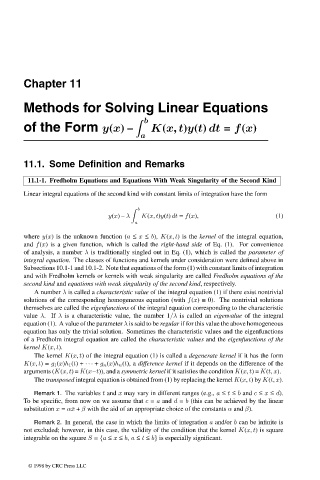Page 544 - Handbook Of Integral Equations
P. 544
Chapter 11
Methods for Solving Linear Equations
b
of the Form y(x)– K(x, t)y(t) dt = f(x)
a
11.1. Some Definition and Remarks
11.1-1. Fredholm Equations and Equations With Weak Singularity of the Second Kind
Linear integral equations of the second kind with constant limits of integration have the form
b
y(x)– λ K(x, t)y(t) dt = f(x), (1)
a
where y(x) is the unknown function (a ≤ x ≤ b), K(x, t)isthe kernel of the integral equation,
and f(x) is a given function, which is called the right-hand side of Eq. (1). For convenience
of analysis, a number λ is traditionally singled out in Eq. (1), which is called the parameter of
integral equation. The classes of functions and kernels under consideration were defined above in
Subsections 10.1-1 and 10.1-2. Note that equations of the form (1) with constant limits of integration
and with Fredholm kernels or kernels with weak singularity are called Fredholm equations of the
second kind and equations with weak singularity of the second kind, respectively.
A number λ is called a characteristic value of the integral equation (1) if there exist nontrivial
solutions of the corresponding homogeneous equation (with f(x) ≡ 0). The nontrivial solutions
themselves are called the eigenfunctions of the integral equation corresponding to the characteristic
value λ.If λ is a characteristic value, the number 1/λ is called an eigenvalue of the integral
equation (1). A value of the parameter λ is said to be regular if for this value the above homogeneous
equation has only the trivial solution. Sometimes the characteristic values and the eigenfunctions
of a Fredholm integral equation are called the characteristic values and the eigenfunctions of the
kernel K(x, t).
The kernel K(x, t) of the integral equation (1) is called a degenerate kernel if it has the form
K(x, t)= g 1 (x)h 1 (t)+ ··· + g n (x)h n (t), a difference kernel if it depends on the difference of the
arguments (K(x, t)= K(x–t)), and a symmetric kernel if it satisfies the condition K(x, t)= K(t, x).
The transposed integral equation is obtained from (1) by replacing the kernel K(x, t)by K(t, x).
Remark 1. The variables t and x may vary in different ranges (e.g., a ≤ t ≤ b and c ≤ x ≤ d).
To be specific, from now on we assume that c = a and d = b (this can be achieved by the linear
substitution x = α ¯x + β with the aid of an appropriate choice of the constants α and β).
Remark 2. In general, the case in which the limits of integration a and/or b can be infinite is
not excluded; however, in this case, the validity of the condition that the kernel K(x, t) is square
integrable on the square S = {a ≤ x ≤ b, a ≤ t ≤ b} is especially significant.
© 1998 by CRC Press LLC
© 1998 by CRC Press LLC
Page 527

